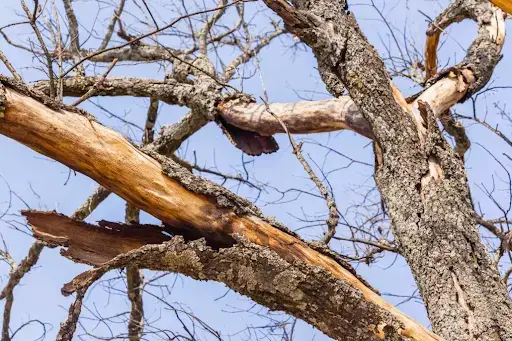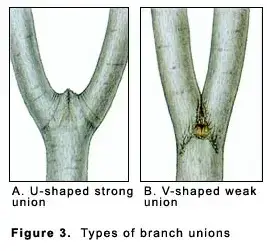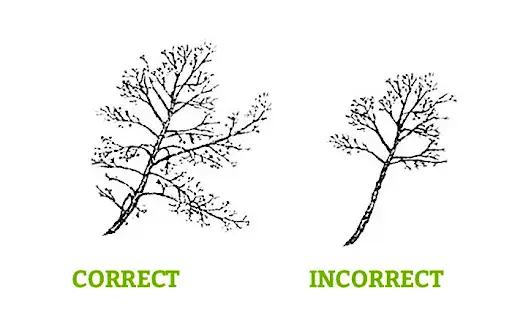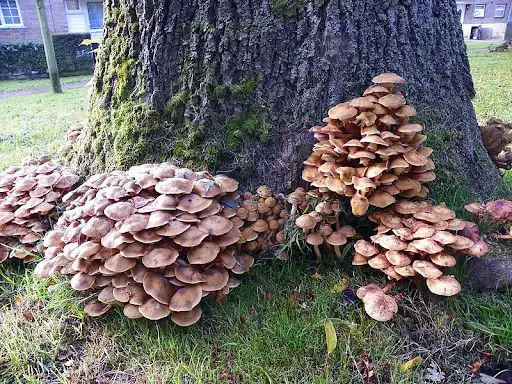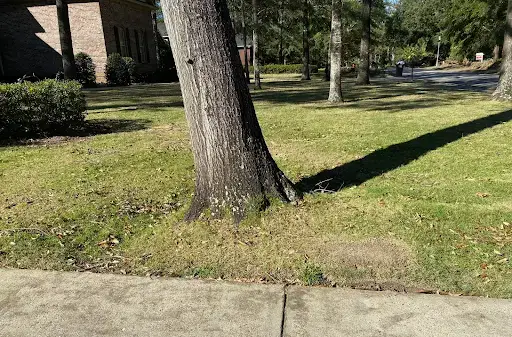written by: Joe Grabinski of Stabile Arbor
Images provided by: Stabile Arbor
~ Rolling hills of vibrant greens fade to shady blues as the sun dominates the sky. With the longer days people are busy filling up their schedules while bees are filling their pockets with pollen. Productivity is at its peak! Nothing seems to slow down this time of year, but one thing will cause us to run and take cover and that’s a summer storm. Though sometimes a bit unpredictable, a storm can bring joy to a community. “We needed this rain!” Adversely, mother nature can bring a bit more than we were asking for. ~
Cause & Effect
Thunderstorms, heavy winds, and flooding are weather events NWPA is experiencing with a greater intensity due to climate change. 1 As arborists we see the impact these weather events have on trees and are called to respond to what is called storm damage. Storm damage occurs when a storm exerts forces on a part of a tree unable to sustain the effect, causing it to fail. 2
Types of Damage
Flooding can lead to failure in the tree’s root system. “Excess soil moisture (waterlogging) prevents adequate aeration by impeding oxygen movement through soil and leaving few water-free pore spaces for oxygen to occupy.” 3 This stresses the tree’s roots because they need oxygen to function properly. Also, roots are more likely to be able to slip through heavily saturated soils, and in the event of high winds after heavy rains you can see trees become uprooted. 4
High winds can test a tree limb’s shear strength to the point of failure. We recommend regular inspection and maintenance as a method to reduce risk of tree limb failure especially for trees where damage resulting from a limb drop could be costly.
Regular maintenance
Regular maintenance gives the arborist an opportunity to remove hazards while also getting to inspect the tree for defects we can’t always see from the ground. The type of maintenance for a tree is variable by age, species, and growing conditions.
Young Trees
Younger trees have a better chance of closing wounds from pruning cuts on live tissue. Structural pruning at a young age can prevent the poor structure that often leads to limb failure. We recommend new plantings undergo structural pruning within its first decade of life.
Mature Trees
Before cutting off large diameter branches of mature trees it’s wise to consider alternatives such as reducing the mass or weight of the outer areas of branches; reducing mass from areas of the tree that are overextending or competing; or adding cabling and bracing to support a tree with structural issues. All of that being said, deadwood/dead branches have already become separated from the living tissue and can be removed more frequently.
Risk Reduction
Here are a few tree defects & possible safety hazards that can be spotted from the ground:
– Dead limbs/ Dead wood: these are large (in diameter+length) branches in the canopy that have been compartmentalized from the live parts of the tree.
– Weak branch attachments: this is when the branch attachment is less than 45° causing it to be very tight at the point of attachment causing bark to become included at the point of union. This included bark is not as strong as other wood and can eventually force the two branches apart.
– Lions tailing: These are long branches with most of the foliage being at the tip of the branch with no inner growth. Lion’s-tailing can increase the risk of branch failure by eliminating the dampening effect that interior limbs provide when branches move during storms.
– Signs of decay (mushrooms): Although not all mushrooms around or on a tree is a death sentence for the tree; the mycelia of honey mushrooms can infect living trees and eventually destroy their roots and lower trunks. This disease is known as “Armillaria root rot” and it occurs throughout the temperate and tropical regions of the world. 5
– Splits/Cracks: usually a long term defect caused by poor structure, pockets of decay or weather events.
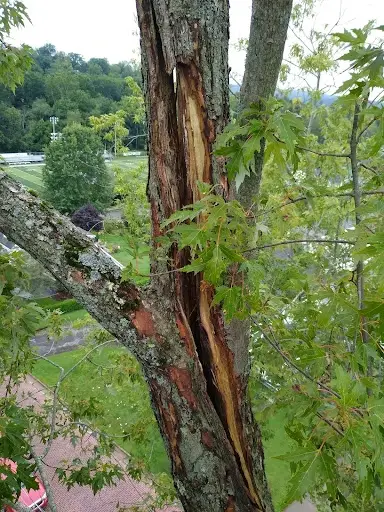
– Heaving trees: a heaving tree can be a result of the effects of flooding mentioned above, or often high winds overexerting the root system leading to tree failure.
Climate Change Preparedness
“Seasonal variations, extreme weather events, catastrophic natural disasters, and climate-related health impacts are becoming more intense and frequent as climate change threatens the health, safety, and overall well-being of communities across the globe” –Meadville Climate Action Plan 2022
It is becoming more apparent that as the climate shifts we must cultivate resilient communities. Trees play a crucial role in the resilience of our communities through stabilizing soils, cleaning the air we breathe, and cooling our planet. It is important we maintain them to the highest standard of care in the tree care industry. 6
Outreach
If you are interested in having an ISA Certified Arborist come assess the “storm readiness” of your trees or have a emergency tree removal or maintenance request you can contact Stabile Arbor directly by clicking here: https://clienthub.getjobber.com/client_hubs/066c07d8-a9b8-4196-88f8-e46d49f3f297/public/work_request/new?source=social_media to fill out a request form.
Sources:
1 Climate Change Effects on Pennsylvania’s Forest
2 Can these trees be saved? Tree recovery after a storm-Tree Damage.
3 Managing Pests in Gardens: Environmental Factors: Aeration deficit—UC IPM.
4 What can you do about flooded trees? | Nebraska Forest Service.

